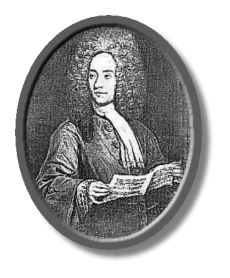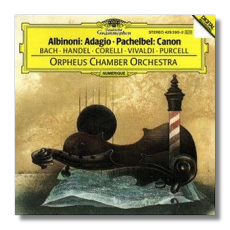
The Internet's Premier Classical Music Source
Related Links
-
Find CDs & Downloads
Amazon - UK - Germany - Canada - France - Japan
ArkivMusic - CD Universe
Find DVDs & Blu-ray
Amazon - UK - Germany - Canada - France - Japan
ArkivMusic-Video Universe
Find Scores & Sheet Music
Sheet Music Plus -
Recommended Links
Site News
Tomaso Giovanni Albinoni

(1671 - 1751)
Tomaso Giovanni Albinoni was born in Venice on June 8, 1671, eldest son of a wealthy paper merchant. At an early age he became proficient as a singer and, more notably, as a violinist, though not being a member of the performers' guild he was unable to play publicly so he turned his hand to composition. His first opera, Zenobia, regina de Palmireni, was produced in Venice in 1694, coinciding with his first collection of instrumental music, the 12 Sonate à tre, Op.1. Thereafter he divided his attention almost equally between vocal composition (operas, serenatas and cantatas) and instrumental composition (sonatas and concertos).
Until his father's death in 1709, he was able to cultivate music more for pleasure than for profit, referring to himself as "Dilettante Veneto" – a term which in 18th century Italy was totally devoid of unfavorable connotations. Under the terms of his father's will he was relieved of the duty (which he would normally have assumed as eldest son) to take charge of the family business, this task being given to his younger brothers. Henceforth he was to be a full-time musician, a prolific composer who according to one report, also ran a successful academy of singing.
A lifelong resident of Venice, Albinoni married an opera singer, Margherita Raimondi (d 1721), and composed as many as 81 operas several of which were performed in northern Europe from the 1720s onwards. In 1722 he traveled to Munich at the invitation of the Elector of Bavaria to supervise performances of I veri amici and Il trionfo d'amore as part of the wedding celebrations for the Prince-Elector and the daughter of the late Emperor Joseph I.
Most of his operatic works have been lost, having not been published during his lifetime. Ten collections of instrumental works were however published, meeting with considerable success and consequent reprints; thus it is as a composer of instrumental music (99 sonatas, 71 concertos and 9 sinfonias) that he is known today. In his lifetime these works were favorably compared with those of Archangelo Corelli and Antonio Vivaldi, and his nine collections published in Italy, Amsterdam and London were either dedicated to or sponsored by an impressive list of southern European nobility.
Albinoni was particularly fond of the oboe, a relatively new introduction in Italy, and is credited with being the first Italian to compose oboe concertos (Op. 7, 1715). Prior to Op. 7, Albinoni had not published any compositions with parts for wind instruments.
The concerto, in particular, had been regarded as the province of stringed instruments. It is likely that the first concertos featuring a solo oboe appeared from German composers such as Telemann or Handel. Nevertheless, the four concertos with one oboe (Nos. 3, 6, 9 and 12) and the four with two oboes (Nos. 2, 5, 8 and 11) in Albinoni's Op. 7 were the first of their kind to be published, and proved so successful that the composer repeated the formula in Op. 9 (1722).
Albinoni's published instrumental works.
- Opus 1 (1694) 12 Trio Sonatas
- Opus 2 (1700) 6 Sinfoniae & 6 Concerti à 5
- Opus 3 (1701) 12 Baletti de Camera (à 3)
- Opus 4 (1704) 6 Sonate da Chiesa for Violin & Bass
- Opus 5 (1707) 12 Concertos
- Opus 6 (1711) 12 Sonate da Camera for Violin & Bass
- Opus 7 (1716) 12 Concertos for Strings / Oboe(s)
- Opus 8 (1721) 6 Sonatas & 6 Baletti (à 3)
- Opus 9 (1722) 12 Concertos for Strings / Oboe(s)
- Opus 10 (1735) 12 Concertos for Violin
Though Albinoni resided in Venice all his life, he traveled frequently throughout southern Europe; the European nobility would also have made his acquaintance in Venice, now a popular destination city. With its commercial fortunes in the Adriatic and Mediterranean in decline, the enterprising City-State turned to tourism as its new source of wealth, taking advantage of its fabled water setting and ornate buildings, and putting on elongated and elaborate carnivals which regularly attracted the European courts and nobility.
Apart from some further instrumental works circulating in manuscript in 1735, little is known of Albinoni's life and musical activity after the mid-1720s. However, so much of his output has been lost, one can surely not put our lack of knowledge down to musical or composition inactivity. Much of his work was lost during the latter years of World War II with the bombing of Dresden and the Dresden State library – which brings us to the celebrated Adagio.
In 1945, Remo Giazotto, a Milanese musicologist traveled to Dresden to complete his biography of Albinoni and his listing of Albinoni's music. Among the ruins, he discovered a fragment of manuscript. Only the bass line and six bars of melody had survived, possibly from the slow movement of a Trio Sonata or Sonata da Chiesa. It was from this fragment that Giazotto reconstructed the now-famous Adagio, a piece which is instantly associated with Albinoni today, yet which ironically Albinoni would doubtless hardly recognize.
Albinoni died in Venice, the city of his birth, on January 17, 1751. ~ Michael Sartorius
Recommended Recordings
Adagio in G minor (arranged by Remo Giazotto)
Sheet Music: Sheet Music Plus
- Adagio with Bach, Corelli, Handel, Pachelbel, Purcell & Vivaldi/Deutsche Grammophon 429390-2
-
Orpheus Chamber Orchestra
- Adagio with Bach, Corelli, Handel, Marcello, Pachelbel, Purcell, Telemann & Vivaldi/Teldec 8573-85557-2
-
Il Giardino Armonica
- Adagio with Barber, Grieg, Holst, Pachelbel & Warlock/Nimbus NI7019
-
William Boughton/English String Orchestra
 Concertos (for Oboe Op. 7 & 9)
Concertos (for Oboe Op. 7 & 9)
- 12 Concertos à 5, Op. 5/Philips 422251-2
-
Pina Carmirelli (violin), Anna Maria Cotogni (violin), Michael Murray-Robinson (viola), Carol Figeriod (viola)/I Musici
- 12 Concertos à 5, Op. 5 with Op. 7/Philips Duo 464052-2
-
Pina Carmirelli (violin), Anna Maria Cotogni (violin), Michael Murray-Robinson (viola), Carol Figeriod (viola)/I Musici
- 12 Concertos, Op. 7 with 2 Sonatas Op. 2/Philips 432115-2
-
I Musici
- 12 Concertos, Op. 7 with Op. 5/Philips Duo 464052-2
-
Jürgen Abel (oboe), Hans Werner Wätzig (oboe), Vittorio Negri/Berlin Chamber Orchestra
- 12 Concertos, Op. 9/Philips Duo 456333-2
-
Heinz Holliger (oboe), Maurice Bourgue (oboe)/I Musici
- 12 Concertos, Op. 10/Erato Ultima 0630-18943-2
-
Piero Toso (violin), Giuliano Carmignola (violin), Claudio Scimone/Solisti Veneti
















